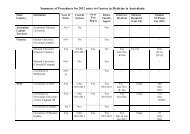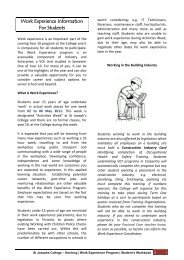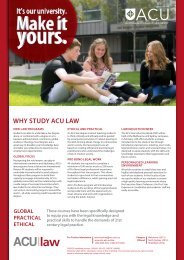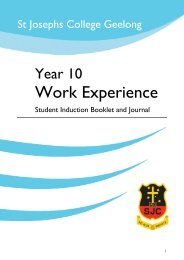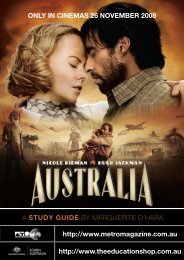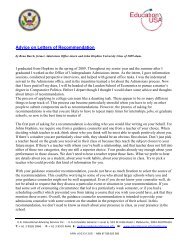Bran Nue Dae
Bran Nue Dae
Bran Nue Dae
- No tags were found...
Create successful ePaper yourself
Turn your PDF publications into a flip-book with our unique Google optimized e-Paper software.
A STUDYGUIDE BY ROGER STITS ONhttp://www.metromagazine.com.auISBN-13-978-1-74295-006-8http://www.theeducationshop.com.au
It’s the summer of 1969 and young Willie’s life revolvesaround the idyllic old pearling port Broome, northernWestern Australia – fishing, hanging out with his matesand, when he can, his girl Rosie. However, his motherTheresa has great hopes for him and sends him back tothe religious mission in Perth for further schooling. Afterbeing punished by Father Benedictus for an act of youthfulrebellion, Willie runs away from the mission. But to where– he’s too ashamed to go home, it will break his mother’sheart. Down on his luck, he meets an old fella whom he calls‘Uncle’ Tadpole, and together they con a couple of hippies,Annie and Slippery, into taking them on the 2500 km journeyback to Broome. Willie learns the hard and funny lessonshe needs to get home, all the while pursued by FatherBenedictus. Arriving back in Broome, Willie wins the girl,convinces his mother that Broome is the place he should beand discovers that the father he never knew he had is hiscompanion all along – Uncle Tadpole.Curriculum linksThis study guide is aimed at middleand upper secondary school levels,with relevance to English, MediaStudies, Drama, Music, IndigenousStudies, History, SOSE/HSIE,Personal and Interpersonal Development,and Cultural Studies.SCREEN EDUCATION2
BackgroundBefore examining the film in detail, we should first look atthe creative forces and elements behind the story’s genesis,and the importance and relevance of its principal settings,Broome and Perth.about the history, culture, environment and developmentof Broome and its people. Has it changed much sincethe late 1960s, the period in which the film is set? Usedesktop publishing software to format your presentation,ensuring that you use an appropriate layout of text,illustrations, headlines and captions.The creative force behind the original stage musical waswriter, composer and musician Jimmy Chi, a residentof Broome. Carry out research on Jimmy Chi then writea short biography and an explanation of why and howhe began to develop <strong>Bran</strong> <strong>Nue</strong> <strong>Dae</strong> into a musical. Forexample, to what extent are aspects of <strong>Bran</strong> <strong>Nue</strong> <strong>Dae</strong>autobiographical?Following from the previous activity, write a short commentaryon the creative work of Jimmy Chi since hedeveloped <strong>Bran</strong> <strong>Nue</strong> <strong>Dae</strong>, especially his work on CorrugationRoad. What is this musical about? In what wayis it autobiographical?Draw a map of Western Australia that shows the locationsof Broome, Roebuck Bay, Port Hedland and Perth,the principal settings of <strong>Bran</strong> <strong>Nue</strong> <strong>Dae</strong>. Include a scalethat indicates distance in kilometres. From evidence orclues you can find in the film, trace the likely route takenby Willie as he travels north from Perth to Broome.Broome is a major feature of <strong>Bran</strong> <strong>Nue</strong> <strong>Dae</strong> and the townis one of the most extraordinary places in Australia, witha fascinating history and cultural mix. Research andprepare an illustrated double-page magazine spreadAn important scene in <strong>Bran</strong> <strong>Nue</strong> <strong>Dae</strong> takes place in anoutdoor cinema in Broome. Find out about Sun Pictures,now promoted as the ‘world’s oldest picture garden’.Create an illustrated promotional poster about Sun Picturesaimed at tourists visiting Broome for the first time.(See ‘Sun Pictures, Broome’ in website references.)Plan and write a short fiction story in which Sun Picturesfeatures prominently. Try to use the unique characteristicsof the setting in the story, particularly how thesecharacteristics might impact on the characters. Yourstory may be written in any style and genre. You maywish to discuss in class the possibilities for plot events,characters, motives and behaviour, and conflict situations.The school Willie attends in Perth in 1969 is ClontarfAboriginal College, which appears in the film. Carry outappropriate research then write a short description ofthe school and the reasons for its existence. Jimmy Chialso drew inspiration from the Pallottine Training Centre,a school in Perth that has connections to Catholicismboth in Germany and Broome. Also write a short commentaryon the history of this establishment and its linksto the Aboriginal populace of Broome and other indigenouscentres in Western Australia.For more on the way in which Clontarf and Father Benedictusare represented during the film, see the Media Studiessection of this study guide.SCREEN EDUCATION3
<strong>Bran</strong> <strong>Nue</strong> <strong>Dae</strong> – characters, motivation,conflictCarry out the following activities on the main characters,their behaviour and motivations, and their relationshiptowards each other.Write a short character sketch of:o Willieo Rosieo Theresao Uncle Tadpoleo Lestero Father Benedictuso Slipperyo AnnieDiscuss in class then write your own analysis of the variousinternalised and externalised conflicts experiencedby Willie. Explore how these conflicts impel the story forwardand decide whether they are satisfactorily resolvedby the end of the narrative. For example, you shouldexamine the conflicting desires between those of Willieand those of Theresa, and how these impact on Willie’srelationship with Rosie. Also look at the emotionalpressures placed on Willie by Father Benedictus and thepower relationship between them.Discuss the importance in terms of the plot of Willie runningaway from school. What is the motivation for thisplot event? Offer an explanation as to why Willie confessesto stealing food from the tuckshop when none ofhis boarding mates does so. How does this scene relateto the fact that Willie is Indigenous? In other words, whydoes he begin to sing ‘There’s nothing I would rather bethan to be an Aborigine’ in this scene?Write a set of personal diary entries about Willie’sdeparture from Clontarf from the viewpoint of one of hisschool friends. You will need to delve deeply into thediarist’s mixed feelings as to what has caused Willie torun away. For example, does the diarist feel guilty? Whatdoes the diarist think about Father Benedictus’ behaviourand methods of discipline?Discuss the following possible view about Willie’s departure:he is running away from, and turning his backon, a formal education that will benefit him in the yearsto come, without having considered or thought abouthis situation at all. Explain whether you would agree ordisagree with this proposition.Following from the previous discussion, the film concludeswith Willie and Rosie in each other’s arms,surrounded by a ‘blackout’ image of a heart. But whatis Willie’s future now that he has returned to Broome?What does he mean when he says, near the end of thefilm, ‘God is here’? What has Willie lost? What has hegained? Do you think the film confronts and resolvesthese issues? Discuss these questions as a class.At one point, Father Benedictus says to Willie, ‘You wantto waste your life like all those useless blackfellows upin Broome?’ Is Benedictus correct or not? What do youSCREEN EDUCATION4
think he means by ‘wasting’ a life and being a ‘uselessblackfellow’? Imagine Willie’s life twelve months afterthe final camera shot. Drawing from the film in terms ofWillie’s character, beliefs, motivations and behaviour,discuss then write a commentary on his life and circumstancesone year later. Where will he be and what will hebe doing? Will he be happy?Explain the motivations behind Uncle Tadpole’s andFather Benedictus’ separate reasons for travelling toBroome. Why is it essential to the outcome of the storythat both characters should arrive in Broome at roughlythe same time?During the brawl between Slippery, Annie and Willie atthe police station, Uncle Tadpole quietly advances tothe counter and removes his hat, bag and vest, whileRoxanne sits quietly on a bench. Explain what youthink these gestures tell us about Uncle Tadpole’s andRoxanne’s lives and past experience, and why it is thatAnnie displays the most outward demonstration of rage.There are, in fact, many other moments in the film whereUncle Tadpole’s actions tell us a great deal about him.Select at least two other incidents from the film whereUncle Tadpole’s actions give us an insight into his characterand life experience.Discuss the narrative purpose of Roxanne’s role in thestory. For example, if she were omitted entirely from theplot, would it have made any difference to the developmentand resolution of the story? Note that during thescene at the ‘condom tree’, Willie refers to her as ‘ablack angel’. Discuss whether we should regard this asrelevant or meaningful in any way.As for the previous activity, discuss the role and purposeof Roadhouse Betty. Is she merely included for laughs?Drawing on Willie’s conflict issues as a starting point fordiscussion, plan and write a short fiction story about ateenager who encounters pressures from parents andothers about fulfilling their hopes and expectations.These demands are in conflict with the teenager’s ownhopes and desires. How will the central character dealwith these emotional issues? What will be the outcome?Consider how you will present the narrative. For example,your choice of writing the story in the first-personor third-person style may dictate the way in which thereader perceives and reacts to the characters and theirrelationships to each other.SCREEN EDUCATION5
Thematic issuesCarry out the following activities, all of which are thematicallyconnected.Indigenous AustraliaAs an introduction to this topic, discuss in class thenwrite a commentary on the range of Indigenous issuesthat are touched upon or raised during <strong>Bran</strong> <strong>Nue</strong> <strong>Dae</strong>,including the relationship between Aboriginal culture andEuropean-Australian society.Discuss the way in which the film depicts and presentsAboriginal homelessness, unemployment and alcoholism.Do you think the film takes a critical stance towardsthe characters who are portrayed in this situation or not?Draw on examples from the film to support your views.Imagine a situation where twodifferent newspapers, each cateringto a specific audience, publisheditorials about ‘parkies’ sittingaround campfires in thebig city (as presented in thescene after Willie escapesfrom his school in Perth).One newspaper is a majorcity tabloid aimed at a general,predominantly whitereadership; the other is a small weekly newspaper run byand for Indigenous Australians.Write the two editorials, in 250–300 words each. Carefullyconsider the audiences you are aiming at andtherefore the editorial’s content, viewpoint and style.When you have finished, add an explanation as to whythe approach you have taken in one editorial is differentfrom the approach taken in the other.Proofread and edit your editorials, then use desktoppublishing software to format them in newspaperfashion. Ensure you give each editorial an appropriateheadline.The effect of Christian missionaries on the lives andeducation of Indigenous Australians is an important elementof the film. Discuss how this is presented in <strong>Bran</strong><strong>Nue</strong> <strong>Dae</strong> and the ways in which it impacts on characterssuch as Theresa, Willie, Uncle Tadpole and Rosie.In commenting on the location of Broome and JimmyChi’s cultural background, the film’s press kit suggeststhat Broome was a place of many cultures where –despite the best efforts of the government to keep themapart – cultures, races and religions mixed. Many inBroome had multiple identities. For example, you couldbe Aboriginal Chinese Japanese Scottish like JimmyChi. ‘You could also be both a saint and a sinner (not soin Perth, where you had to be one or the other).’Discuss in class whether the film version of <strong>Bran</strong> <strong>Nue</strong><strong>Dae</strong> supports the statement about saints and sinners.There are two sequences in the film where charactersconfess to committing sins. Describe these twosequences and the outcome of each. Discuss, withevidence, whether they are similar to, or different from,each other.Carry out research on the history of Christian involvementin the lives of Indigenous Australians. To whatextent was this involvement productive or disruptive forAboriginal children, families and culture? Plan and writea commentary on this issue in 350–400 words.SCREEN EDUCATION6
theme of racial reconciliation, in terms of plot events,physical movement and gestures of characters, andsong and dance.Also consider whether there is an underlying element ofsatire and irony in these scenes, especially through theuse of Anglo-American stage and movie musical genrecharacteristics. (Note that Jimmy Chi, the original creatorof the play, spent his childhood and youth watchingAmerican movies screened at Sun Pictures.)A major element of the relationship between Indigenousand non-indigenous cultures in Australia is played outsatirically via the relationship between Uncle Tadpole,Slippery and Annie. It is not simply a case of blatantracial prejudice nor of the dominant culture oppressing aminority culture. Discuss these two combined propositions,drawing examples from <strong>Bran</strong> <strong>Nue</strong> <strong>Dae</strong> to supportyour views.Discuss in class then write a commentary on the ways inwhich the history of European colonialism and the resultingdislocation and oppression of Aboriginal peoples isexamined in <strong>Bran</strong> <strong>Nue</strong> <strong>Dae</strong> through the roles of UncleTadpole and Willie. Concentrate on the visuals of thenight-time dream sequence in the police lockup cells.What is the story told throughout these visuals? In whatway is visual symbolism used? Why do you think thecentral character shifts from Uncle Tadpole to Willie?Following from the previous activity, listen carefully tothe lyrics of ‘Listen to the News’ as sung during thedream sequence. Discuss in class what you think thissong is about. What, for example, is the ‘news’ of thetitle? Explain the emotional impact of the song uponyou and upon audiences generally. For example, is itdepressing and negative, or does it raise our spirits?When Willie questions Uncle Tadpole about the dream,Uncle Tadpole remarks, ‘Those are the old people lookingafter us.’ Either individually or in pairs, compose,revise and refine either a short poem or a song about therelationship between the ancestors, the Dreaming andcontemporary Indigenous people seeking a pathwaythrough life.In small groups, plan and draft a script for a short playabout racial reconciliation in Australia. Consider thecharacters, setting, themes and events, as well as thegeneral approach to the presentation. For example,should you include humour or even comedy in your portrayalof the subject matter? Rehearse a reading of thescript and revise as necessary. You may wish to organisea performance for a class in your school.An alternative may be to prepare the script for soundonly (narration, dialogue, sound effects and music),then to record and edit it for playback on your school’sintranet.Home, a sense of place and belongingWhen Willie first meets Uncle Tadpole in Perth, UncleTadpole and his mates are singing ‘Long Way AwayFrom My Country’. Listen carefully to the words, thendescribe the purpose of this song. What is it suggestingabout the men grouped around the campfire? In whatway does this song reflect Willie’s own thoughts andfeelings, and encapsulate a major plot-driven aspect ofthe film?ReconciliationIn 2008, Prime Minister Kevin Rudd offered an official‘Sorry’ to Indigenous Australia as a gesture of reconciliation.At that time, the film version of <strong>Bran</strong> <strong>Nue</strong> <strong>Dae</strong> wasin development, being released theatrically in early 2010.Examine the final scenes of the film, which take place onthe beach near Broome and outside the Roebuck BayHotel. Discuss in class then write a commentary on howthese scenes capture and depict the mood, spirit andSCREEN EDUCATION7
Discuss how the idea of Broome as home is contrastedin Willie’s mind and imagination with his actual physicalenvironment in Perth. (For more on this general subject,see the Media Studies section.)Have you ever felt homesick? Describe the feeling. Whatis homesickness and what causes it? Is it merely a stateof mind? Is it a deeper connection to a specific environmentand to the land? Write a personal piece in 100words about the concept of home, either a place thatyou call home or where you feel you belong.Write a short fiction story about a character returninghome. Why is that character returning home? Do we,as readers, need an explanation, or could it be left asa mystery? Does the character want to return home ornot? What will he/she find on arrival?The journeyMuch of <strong>Bran</strong> <strong>Nue</strong> <strong>Dae</strong> is a road movie: a journeythrough a landscape of learning experiences that signifya changing perspective. Discuss and write a commentaryon Willie’s emotional, spiritual and educationaljourney, which begins and ends in Broome. Has Williechanged? What has he discovered and learned? Examinethe role and the effect on Willie of Uncle Tadpole asfather figure, protector, mentor and guide. You may wishto compare or contrast the role of Father Benedictus insimilar fashion. Comment on Willie’s sense of self-identityat the film’s conclusion. Is it different from the way heviews himself early in the film? Do other characters viewhim differently?For more information, see ‘Road Movies’ section in websitereferences.Plan and write a short story about a character who undertakesa journey of self-realisation. For plot purposes,this need not be a long physical journey or an ‘odyssey’across a strange landscape; rather, it may only be aquick trip across a suburb, but one that turns out to beof major significance. A simple example might involve aman whose wife is about to give birth to a baby.SCREEN EDUCATION8
References and further resourcesBooksRebecca Coyle, Reel Tracks: Australian Feature Film Musicand Cultural Identities, John Libbey, Eastleigh, 2005.Rosemary Hemphill, The Master Pearler’s Daughter: Memoriesof My Broome Childhood, Pan Macmillan, Sydney,2004.Sue Jackson, When History Meets the New Native Title Eraat the Negotiating Table: A Case Study in Reconciling LandUse in Broome, Western Australia: A Discussion Paper,Darwin North Australia Research Unit, Australian NationalUniversity, 1996.John Kenneth Muir, Singing a New Tune: The Rebirth of theModern Film Musical, From Evita to De-lovely and Beyond,Applause Theatre and Cinema Books, New York, 2005.Susan Sickert, Beyond the Lattice: Broome’s Early Years,Fremantle Arts Centre Press, Fremantle, 2003.Jill Stubington, Singing the Land: The Power of Performancein Aboriginal Life, Currency House, Strawberry Hills, 2007.Noel Trevor (ed.), Why Broome?, Noel Trevor & Associates,Cable Beach, 2000.FilmsThe Story of <strong>Bran</strong> <strong>Nue</strong> <strong>Dae</strong>25-minute documentary on the making of the film. Screenedon ABC1’s Message Stick and included as an extra on the<strong>Bran</strong> <strong>Nue</strong> <strong>Dae</strong> DVD.The Circuit, series one and two (2007-2009)SBS drama series set in Broome. Distributed by Madman.Sisters, Pearls & Mission Girls (David Batty, 2004)Documentary about Christian missionaries in the Kimberley,Western Australia. Distributed by Rebel Films.One Night The Moon (Rachel Perkins, 2001).Musical drama by director of <strong>Bran</strong> <strong>Nue</strong> <strong>Dae</strong>. Distributed byDendy FilmsLord of the Bush (Tom Zubrycki, 1990).Documentary about Broome. Distributed by Ronin Films.<strong>Bran</strong> <strong>Nue</strong> <strong>Dae</strong> (Tom Zubrycki, 1991).This documentary about Jimmy Chi and his creation of theoriginal stage production is not to be confused with thefeature film of the same title. Distributed by Ronin Films.SCREEN EDUCATION10
Websites<strong>Bran</strong> <strong>Nue</strong> <strong>Dae</strong>:,accessed 28 May 2010., accessed 28 May 2010., accessed 28 May 2010., accessed 28 May 2010.Broome:,accessed 28 May 2010., accessed28 May 2010.Jimmy Chi:,accessed 28 May 2010.Musicals:,accessed 28 May 2010.Pallottine Training Centre:, accessed 28 May 2010., accessed28 May 2010.Rachel Perkins (film director):, accessed 28May 2010., accessed 26 May 2010.Road Movies:, accessed 26May 2010., accessed 26May 2010.Roebuck Bay Hotel:, accessed 28 May2010.Clontarf Aboriginal College:, accessed 28 May 2010.Kuckles:, accessed 28 May2010., accessed 28 May 2010.Sun Pictures, Broome:, accessed 25 May2010.Roger Stitson is a freelance writer and a former secondaryteacher with an M.Ed. in media and literature studies.SCREEN EDUCATION11
This study guide was produced by ATOM.(© ATOM 2010) ISBN-13-978-1-74295-006-8editor@atom.org.auFor more information on SCREEN EDUCATION magazine,or to download other study guides for assessment,visit .Join ATOM’s email broadcast list for invitations tofree screenings, conferences, seminars, etc.Sign up now at .For hundreds of articles on Film as Text,Screen Literacy, Multiliteracy and Media Studies,visit .Notice: An educational institution may make copies of all or part of this study guide, provided that it only makes and uses copiesas reasonably required for its own educational, non-commercial, classroom purposes and does not sell or lend such copies.



